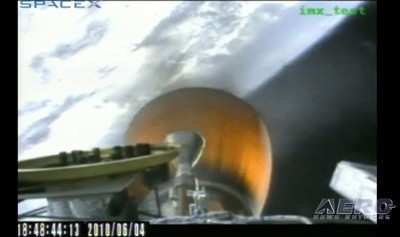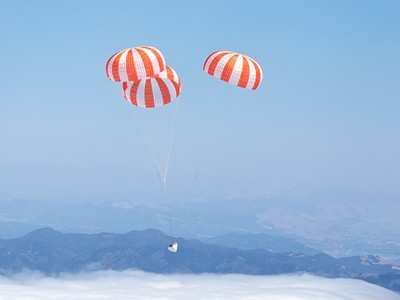News/Analysis by Wes Oleszewski
With the date rapidly approaching for the initial attempt to
launch the second of SpaceX's Falcon 9 vehicles, it is important to
look at what this launch could mean. The meaning is important not
only to SpaceX, but rather to the United States as a whole.

Having successfully completed its flight readiness static firing
test on Saturday morning, the second Falcon 9 launch vehicle is
currently poised to fly its mission on Tuesday December 7.

Officially, this launch a Falcon 9 is the COTS-1 Demonstration
mission. COTS, (the Commercial Orbital Transportation Services), is
a program by which NASA has contracted two private companies to
transport cargo to the ISS (the International Space Station)
following the retirement of the Space Shuttle. SpaceX was one of
the contract winners for COTS and currently they have the ability
to place payloads into orbit. On June 4, 2010 the first of SpaceX's
Falcon 9 launch vehicles lofted a boilerplate version of the
company's Dragon capsules into orbit. That capsule, as planned,
burned up on reentry 23 days later. Now, the first official COTS
demonstration will see a Falcon 9 boosting a flight version of the
Dragon capsule. That capsule is scheduled to reenter and splash
down in the Pacific Ocean after three orbits.

To the casual observer, this flight may represent little more
than orbiting an empty capsule. To the critics of SpaceX it
represents something that NASA did way back on September 13, 1961
with the Mercury Atlas 4 flight. To someone who looks at it with a
wider perspective, however, this flight has far-reaching
implications that go way beyond SpaceX.

With the Space Shuttle retiring, United States astronauts will
be forced to hitch rides aboard the Russian Soyuz. Thus, until the
USA regains a capability to fly our own people on our own vehicles,
our access to space will be restricted to the Soyuz and will cost
between $51 million and $55 million dollars per ride. That is more
than double the price that our Russian "partners" have been
charging to fly space tourists and there is absolutely nothing to
keep the Russians from additional inflation of the price after 2014
when the Shuttle is gone and their Soyuz is the only game in town.
The cold fact is, they can charge whatever price they want and if
we Americans want to get to the ISS that the US taxpayers have
invested some $100 billion in, we have to pay it what the Russians
see fit to charge. Thus, the quicker that the United States regains
autonomous access to space- the better.

That in mind, the Congress has directed NASA to expedite the
development of the SLS (Space Launch System) heavy lift booster and
the Orion crew vehicle. This process, however, is bogged down in
NASA's own thicket of bureaucracy as well as the Congress' own
inability to pass a budget for the agency. Meanwhile, Boeing's
CST-100 crew capsule, which is intended to compete with the Dragon,
is still little more than data on a hard drive as is the
multi-developer sponsored Dreamchaser spacecraft. Additionally, the
other proposed booster for COTS, operated by Orbital, is far behind
the point of development achieved by SpaceX's Falcon 9. Some
critics are quick to point out that SpaceX has only one flight of
the Falcon 9 to its credit. Yet, even though SpaceX has
successfully flown only one Falcon 9 so far, they have working
hardware and software. Thus, the best bet for the United States to
regain access to space is currently the Falcon 9.

Yet another implication of the importance of this Falcon 9
orbital shot resides in the role of the Russian vehicles acting as
the one and only access to the ISS. Although the Russian vehicles
have demonstrated great reliability, even a concrete sidewalk can
crack. Should the Soyuz or its launch vehicle experience any sort
of catastrophic accident it would make access to the ISS impossible
because there will be no back-up to the Soyuz. In such a
circumstance, mankind may have to abandon the ISS when its
consumables run out, or worse- a crew may find themselves marooned
on the station itself. A booster failure would leave the Soyuz
grounded while an investigation takes place and a fix is found. Any
crew on the station would still be able to return to earth by way
of the Soyuz lifeboats that are always docked to the station. If,
however, there is a catastrophic event aboard the Soyuz on reentry-
similar to, but worse than those that took place in the last few
years- and the lifeboat vehicles are found to be unsafe for
reentry, anyone aboard the station would be marooned there until
the problem is investigated and the system is fixed. Should either
of these scenarios take place, we could lose the ISS- or worse. The
only solution to this issue is to get a United States space access
capability up and running as fast as possible. Falcon 9 is the only
active player in that game right now.

So, the pending launch of the second Falcon 9 holds implications
far beyond furthering the success of an up-start rocket company.
The United States has been a space faring nation for a half a
century. Now, due largely to political fiddling, and general poor
planning in Washington DC, the US is poised to fumble the ball of
leadership in human spaceflight. SpaceX appears to be emerging as
our best chance to regain the ball and help narrow the gap in US
human spaceflight while ensuring the nation's investment in the
ISS.
 ANN's Daily Aero-Linx (12.03.25)
ANN's Daily Aero-Linx (12.03.25) ANN's Daily Aero-Term (12.03.25): CrewMember (UAS)
ANN's Daily Aero-Term (12.03.25): CrewMember (UAS) NTSB Prelim: Maule M-7-235A
NTSB Prelim: Maule M-7-235A Airborne-Flight Training 12.04.25: Ldg Fee Danger, Av Mental Health, PC-7 MKX
Airborne-Flight Training 12.04.25: Ldg Fee Danger, Av Mental Health, PC-7 MKX Aero-News: Quote of the Day (12.04.25)
Aero-News: Quote of the Day (12.04.25)









